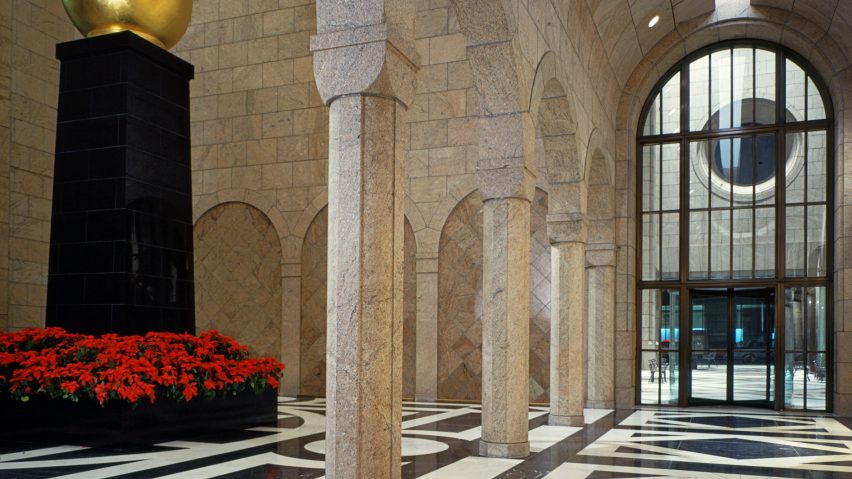As demolition work begins on the lobby of Philip Johnson's AT&T Building, now known as 550 Madison, Municipal Art Society of New York chair Christy MacLear emphasises the building's architectural significance and warns of the limitations of the city's current preservation process.
As thousands of New Yorkers go about their work days, a monument is being gutted in the heart of Midtown. There are no witnesses: the building's new owner papered over the windows at 550 Madison Avenue long before anyone could see them dismantle its soaring lobby. By the time we found out what was afoot, the damage was done.
Known as the former AT&T Building, 550 Madison Avenue is New York's most iconic example of postmodern architecture. Its architect, Philip Johnson, famously appeared on the cover of Time Magazine holding the model proudly – even defiantly – in his arms.
Johnson's design boldly reintroduced stone to the Midtown skyline after a generation of steel and glass. When finished, its broken pediment nosed its way into the skyline alongside the delicate spires of the Empire State Building and Chrysler Building. Love, like, or hate, 550 Madison became a fixture of our urban fabric.
Crucially, Johnson designed the building both inside and out in one unified vision. With a single client and a limitless budget, he was free to reach for the highest quality one could imagine eschewing the steel and glass modernism of the day for the finest materials and grandest architectural gestures of the past, arranged in new and arresting ways.
Buildings cannot be designated as landmarks in New York City until 30 years after their completion
The lobby's atrium was intentionally cavernous, large enough for AT&T's famous Spirit of Communication statue to sit on a pedestal in the centre. The 16-tonne bronze sculpture, nicknamed Golden Boy, was one of the largest in the city when it was first hoisted onto the roof of AT&T's downtown headquarters in 1916.
Entering 550 Madison, visitors were transported through an architectural expression of corporate culture: the experience of proceeding through the lobby, up the elevators, and into the private spaces directly represented the stages of power and privacy.
Its story has never been an easy one: commissioned in 1978 at the height of AT&T's "Ma Bell" era, the building was designed to impress, and even intimidate. By the time it opened in 1984, mighty AT&T – the Google of its day – had been broken apart by the Department of Justice's anti-trust efforts.
The building was later sold to Sony, undergoing a renovation as it changed hands. Golden Boy was dismantled and moved to Dallas. The sweeping pedestrian arcades were closed in and converted to retail space.
By the time the opportunity to designate comes along, many buildings have been picked apart
Today, the 37-storey tower sits vacant. Its new owners, like the ones before, argue that it is a tough sell for commercial clients – an imposing, corporate fortress in the millennial era of WeWork. The stately lobby, a pitch-perfect design for the client and time in which it was conceived, became a target.
The demolition of the AT&T lobby may never rank alongside the most gut-wrenching losses in the preservation movement. This is not a wrecking ball against the imperial eagles of Old Penn Station. But it is indicative of something else familiar and pervasive in our city: the tragic limits of the landmark process, especially for interiors.
There is no mechanism to protect modern-day monuments from the "death by a thousand cuts" that the pressures of money and fashion exact during the intervening years between construction and designation.
Buildings cannot be designated as landmarks in New York City until 30 years after their completion. There is a certain logic to this: icons are easier to identify a generation later. But in the interim, buildings change hands. New owners tweak the design in response to the market and the styles of the times.
550 Madison's current owners owed New York City more than a cheap dodge to achieve their ends
Johnson's tower is a perfect example. This is our city's postmodern masterpiece – it has the quality and references to stand the long test of time. And yet we consider it disposable to the fashion of the day.
By the time the opportunity to designate comes along, many buildings – particularly their interiors – have been picked apart. No longer seen as the original design of the architect, they can't be protected. And so they are lost, as the lobby of 550 Madison is now.
550 Madison is a building worthy of the greatest respect and most careful preservation. It was designed with the strength of an unerring vision and built with a budget that allowed unprecedented attention to detail. The current owners owed New York City more than a cheap dodge to achieve their ends. Their action makes the bar for their alterations to the balance of the building all the higher.
Photograph is by Brian Rose.

